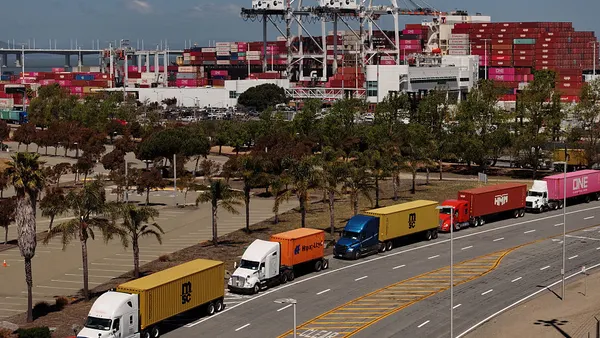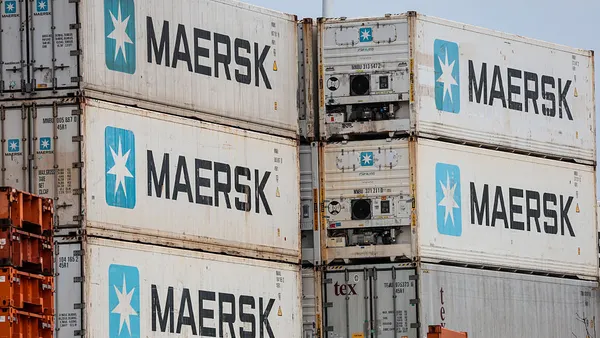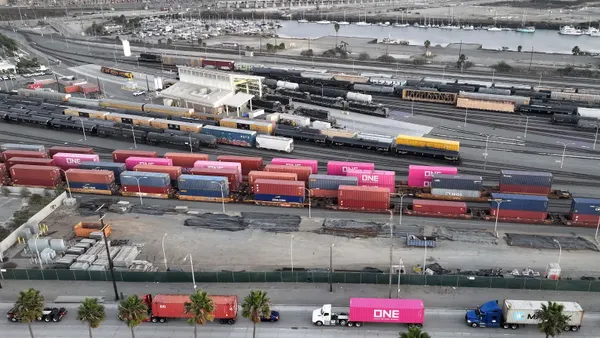Dive Brief:
- Truck postings on the spot market began to show signs of growth in June, growing 13% compared to May. This was relatively flat on a YoY basis, increasing 0.3% YoY, according to the latest figures from DAT.
- Demand remained higher than at the same point last year, with spot posts up more than 101% YoY, but posts fell 6% compared to May. DAT Principal Analyst Dean Croke said this is the result of more shipments moving to the contract market as carriers have been able to secure higher rates there, reducing the incentive to focus on the spot market.
- The entry of new capacity into the market along with a dip in demand compared to May did manage to keep rates level. Van and reefer rates fell by 0.2% and 0.1% compared to May, respectively, but were both still elevated compared to June 2020.
Supply inches closer to demand on spot market
Dive Insight:
The shipment figures from DAT align with the latest Cass Freight Index report, which showed that shipments declined by 4.2% in June compared to May.
"Fading Federal stimulus was likely a contributor, but our industry discussions suggest shipment volumes continue to be hindered by supply constraints, which range from driver and trailer shortages in TL and LTL to chassis shortages hampering intermodal capacity," Cass wrote in its report.
But Cass' rates and expenditure figures, which include information for freight outside of the spot market alone, both jumped compared to May and June 2020. Rates grew more than 23% YoY and 12% compared to May.
Cass noted the month-to-month shifts in rates were partially explained by the type of shipments that were in the market. "The proportion of smaller/lower-cost LTL shipments in the data set rose in May, then returned to a more normal level in June, and this mix shift pressed total embedded rates higher in June just as it pressed the series lower in May," the report explained.
The spot rates in the trucking market have increased to impressive levels over the last year and shippers are starting to see that in their contract rates, Croke said.
"What shippers have had to deal with is a lot of the procurement costs escalated throughout the year, and then they went into this period of absolutely crazy spot price volatility late last year when they were doing their 2021 bids for capacity," he said.
The high rates, increase in number of shipments and the downturn in demand in 2020 resulted in the expenditure figure for June growing at the "fastest pace ever" on a YoY basis, surging more than 56% YoY.
But higher contract rates have not translated into strong commitments when it comes to capacity.
"Tight capacity on the truckload side has meant the carriers are only accepting about three-quarters of all the [contract] loads that shippers send out to them," Croke said.
As shippers see an uptick in demand for their products across industries, carriers have struggled to accept this surge volume, he said, noting that this results in shippers turning to carriers offering higher rates in the routing guide or the spot market.
The rates in contracts keep getting higher too. DAT has seen that the contracts entering routing guides have increased 7% in the last two weeks compared to the previous two weeks.
"The fact that we're in almost the middle of July, and contract rates are still increasing by a factor of 7% in the last two weeks over the prior two weeks ... that's what's really hurting shippers at the moment" by causing higher procurement costs, Croke said.
The market has seen an impressive amount of capacity enter the market, about 60,000 new truck companies in the last year. But this still hasn't been enough to keep up with demand for moving, he said.
The shortage is driven by a few factors, including equipment manufacturers struggling with component shortages and a shortage of drivers to sit behind the wheel of these vehicles. Croke noted that record-high pay increases have started to show signs of bringing workers back into the driver's seat.
But when exactly supply will begin to meet demand is harder to pinpoint, especially with peak season a few months away.
"Retailers are still playing catch up from depleted inventories from this time last year," Croke said. "They still haven't been rebuilt the inventories to anywhere near pre-pandemic levels."














